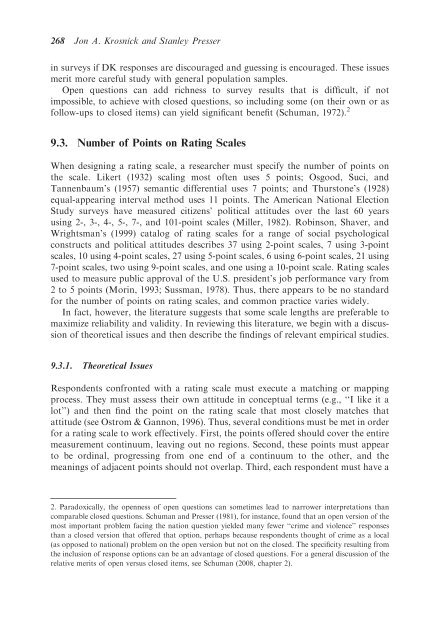Question and Questionnaire Design - Stanford University
Question and Questionnaire Design - Stanford University
Question and Questionnaire Design - Stanford University
You also want an ePaper? Increase the reach of your titles
YUMPU automatically turns print PDFs into web optimized ePapers that Google loves.
268 Jon A. Krosnick <strong>and</strong> Stanley Presserin surveys if DK responses are discouraged <strong>and</strong> guessing is encouraged. These issuesmerit more careful study with general population samples.Open questions can add richness to survey results that is difficult, if notimpossible, to achieve with closed questions, so including some (on their own or asfollow-ups to closed items) can yield significant benefit (Schuman, 1972). 29.3. Number of Points on Rating ScalesWhen designing a rating scale, a researcher must specify the number of points onthe scale. Likert (1932) scaling most often uses 5 points; Osgood, Suci, <strong>and</strong>Tannenbaum’s (1957) semantic differential uses 7 points; <strong>and</strong> Thurstone’s (1928)equal-appearing interval method uses 11 points. The American National ElectionStudy surveys have measured citizens’ political attitudes over the last 60 yearsusing 2-, 3-, 4-, 5-, 7-, <strong>and</strong> 101-point scales (Miller, 1982). Robinson, Shaver, <strong>and</strong>Wrightsman’s (1999) catalog of rating scales for a range of social psychologicalconstructs <strong>and</strong> political attitudes describes 37 using 2-point scales, 7 using 3-pointscales, 10 using 4-point scales, 27 using 5-point scales, 6 using 6-point scales, 21 using7-point scales, two using 9-point scales, <strong>and</strong> one using a 10-point scale. Rating scalesused to measure public approval of the U.S. president’s job performance vary from2 to 5 points (Morin, 1993; Sussman, 1978). Thus, there appears to be no st<strong>and</strong>ardfor the number of points on rating scales, <strong>and</strong> common practice varies widely.In fact, however, the literature suggests that some scale lengths are preferable tomaximize reliability <strong>and</strong> validity. In reviewing this literature, we begin with a discussionof theoretical issues <strong>and</strong> then describe the findings of relevant empirical studies.9.3.1. Theoretical IssuesRespondents confronted with a rating scale must execute a matching or mappingprocess. They must assess their own attitude in conceptual terms (e.g., ‘‘I like it alot’’) <strong>and</strong> then find the point on the rating scale that most closely matches thatattitude (see Ostrom & Gannon, 1996). Thus, several conditions must be met in orderfor a rating scale to work effectively. First, the points offered should cover the entiremeasurement continuum, leaving out no regions. Second, these points must appearto be ordinal, progressing from one end of a continuum to the other, <strong>and</strong> themeanings of adjacent points should not overlap. Third, each respondent must have a2. Paradoxically, the openness of open questions can sometimes lead to narrower interpretations thancomparable closed questions. Schuman <strong>and</strong> Presser (1981), for instance, found that an open version of themost important problem facing the nation question yielded many fewer ‘‘crime <strong>and</strong> violence’’ responsesthan a closed version that offered that option, perhaps because respondents thought of crime as a local(as opposed to national) problem on the open version but not on the closed. The specificity resulting fromthe inclusion of response options can be an advantage of closed questions. For a general discussion of therelative merits of open versus closed items, see Schuman (2008, chapter 2).
















